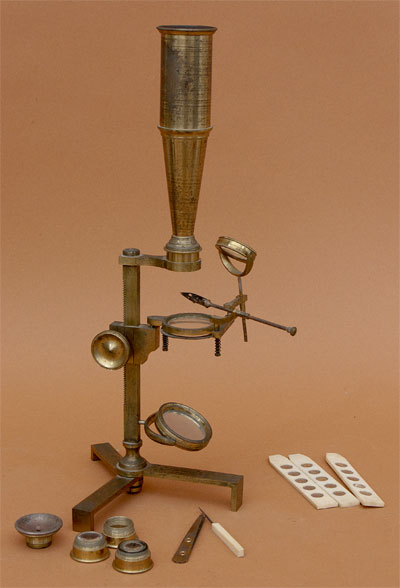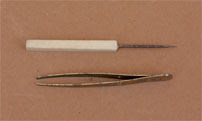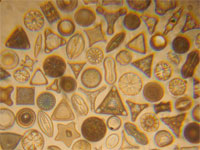 |
|||||
 |
 |
||||
 |
|||||
 |
 |
||||
Gould-Style Compound Microscope (No. 15 ) |
|||||||||||
 |
Age: 1800–1820 Made by: unknown Made in: probably England |
||||||||||
 |
|||||||||||
|
Accessories
|
|||||||||||
 |
|||||||||||
|
Imaging
|
|||||||||||
|
William Cary (1759-1825) was a prominent maker of "Mathematical Instruments" (including microscopes) located on the Strand, London. This microscope, and several others in the Golub Collection, was designed by one of his apprentices, Charles Gould, while he was working in the Cary firm, possibly after Cary's death. In 1827 Gould published a booklet entitled The Companion to the Microscope and a Description of C. Gould's Improved Pocket Compound Microscope... describes microscopes of tis design for the first time. After Cary's death the firm continued using Cary's name, where it was managed by Cary's nephews, and it continued to make microscopes of this style for a quite a number of years. Eventually Gould left the company to establish another firm as "Gould and Porter". An instrument of this type was called a "pocket microscope" because of its size and portability. Microscopes of this general design continued to be made well into the 19th Century due to their popularity among the many people with interests in natural history. This type of instrument often varied in design, some larger, some with the pillar mounted on the front edge of the box, some mounted on the top of the box, some with more traditional folding legs (like this instrument), some signed, and some unsigned. These microscopes have often been called "Cary-style microscopes," while Charles Gould has become more of a footnote in spite of his creativity. To give credit to the actual designer of the microscope, the Pocket Microscope design should be called "Gould-style." This instrument is a small, free-standing version of the popular Gould-type pocket microscope. The microscope support consists of a folding tripod stand with a rectangular pillar. The illuminating mirror is mounted to the lower part of the pillar by pressing its support pin into a hole in the pillar. The sample stage is mounted, via a pin, to the pinion mount of the focus mechanism. The rack is machined directly into the back of the support pillar. The stage has a large circular cutout for several accessories (aquatic slide, B/W disc), and two holes for the Bull's Eye lens and stage forceps. The microscope body has the typical Gould-style optics except for the Ramsden eyepiece, which is atypical for that era. The microscope comes with four objectives, one of which is integral to a Lieberkuhn reflector. Imaging is very good, but does exhibit chromatic aberration. The microscope can be disassembled and folded in a mahogany storage and carrying case. Accessories include a bone-handle pointer, a brass forceps, and four bone sample slides. The microscope is unsigned so we do not know the maker, however it is undoubtedly English. This instrument is 28cm tall. The Golub Collection is fortunate to have a number of Gould-Style microscopes. Featured 10/2016 |
|||||||||||